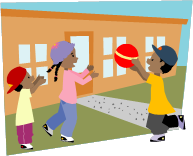Brain Breaks
 Purpose:
Purpose:
Brain Breaks allow Discovery Students to recharge, refresh and refocus at school and HOME!
Teachers at Discovery have found that brain breaks taken every 15-30 minutes increase attentiveness, concentration, and focus. Brain breaks also increase circulation, coordination, and physical fitness. These one to five minute fitness breaks activate the brain and improve on-task behavior. Movement increases oxygen-rich and glucose-rich blood flow to the brain which increases the students’ ability to concentrate. It also enhances memory. Breathing and stretching exercises calm and clear the mind, relieving tension and stress.
At HOME, Brain Breaks are useful while your child is doing homework. Your child can come up with a brain break or you can use the suggestions below. Remember: “brain research confirms that physical activity – moving, stretching, walking – can actually enhance the learning process” (Eric Jensen: Moving with the brain in Mind).
Brain Break Suggestions for Home
Go to www.gonoodle.com and sign up for a free parent account!
Brain Breaks can also be found on YouTube and Pintrest. Parents are encouraged to preview for suitability.
Head/Shoulders/Knees/Toes Cross the arms and touch your earlobes, uncross the arms and touch your shoulders, cross the arms and touch your knees, then uncross the arms and touch your toes. Keep repeating and see how fast you can go.
One Leg Hop & Spin Stand on one leg, holding the foot of the other leg. Spin and hop in a clockwise motion. Go counter-clockwise, too.
Brain Breaks for Home
Sports Moves
For short brain breaks, you can call out some of the following sports skills for your child to mimic, pretending to have the necessary equipment:
- Shooting a jump shot
- Running through tires
- Batting a baseball
- Serving a tennis ball
- Bowling
- Downhill or cross-country skiing
- Spiking a volleyball
- Swinging a golf club or putting with a golf club
- Throwing a football
- Juggling a soccer ball or shooting for the goal or passing to another player
- Shooting an arrow
- Shooting a hockey puck
- Swimming: different strokes, swimming underwater, jumping into the water
- Fielding a ground ball and throwing it to a base
- Dunking a basketball
- Think up any sport and do its move.
Variation: Integrate skills into word problems and have your child repeat the number of the answer Or repeat a number called out—e.g., “If Bob made 5 jump shots (students act this out) and 2 went in the basket, how many did he miss? 3.
Figure 8’s with “8” lying on its side
- Draw a figure 8 five times with one hand, then the other, then with both hands together.
- Elbow 8’s: Draw with each elbow 5 times, then with both elbows simultaneously.
- Shoulder 8’s.
- Snap fingers on both hands while making a figure eight shape.
The Calf Pump
Helps you to be more motivated and ready to move.
Teaching tips:
- Lean forward & put 2 hands on desk, chair or table.
- Place one leg behind you resting on ball of foot (front knee is bent).
- Press heel to ground slowly 3 times (do 3 sets of 3).
- Switch legs.
Academic skills enhanced: listening, reading comprehension, creative writing
The Gravity Glider
Relief after sitting too long.
Teaching tips:
- Sit comfortably, cross ankles, keep knees relaxed, bend forward and reach out in front of you. Let arms go up as you inhale, glide down as you exhale a couple of times.
- Change legs and repeat.
Academic skills enhanced: reading comprehension, mental math, abstract thinking
The Grounder
Helps students focus.
Teaching tips:
- Standing, legs spread comfortably wide apart
- Point right foot toward the right; left foot straight ahead
- Inhale, then exhale and bend right knee
- Inhale as you straighten the right leg back up
Variation: Repeat 3 times, then repeat on the left. You can add arm movements if you wish
Academic skills enhanced: comprehension, short term storage and long term recall, computation skills, self-expression
The Cross Crawl
Helps new learning as brain hemispheres work together.
Teaching tips:
- When an arm moves, the leg on the opposite side of the body moves at the same time.
- Move to the front, sides, and back
- At the end, touch hand or elbow to opposite knee to cross the mid-line.
Academic skills: reading & reading comprehension, writing, spelling, listening
